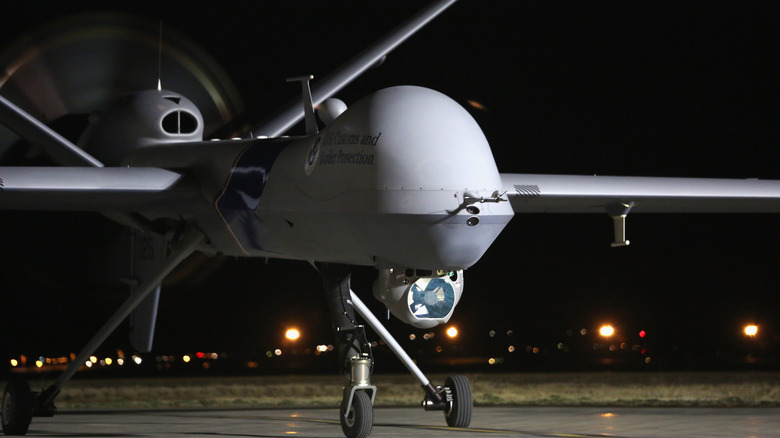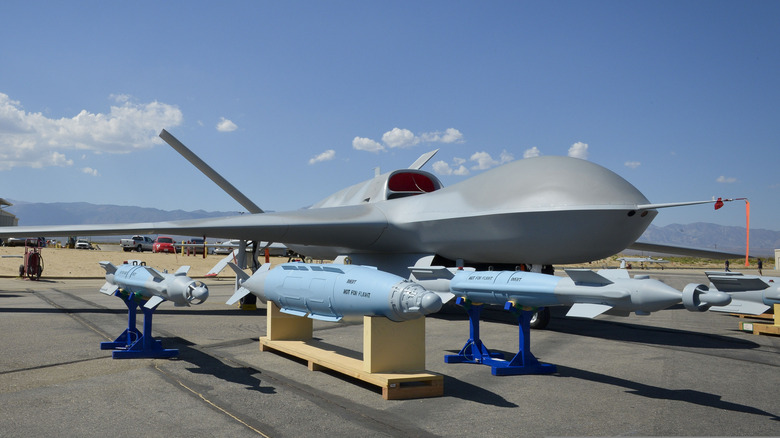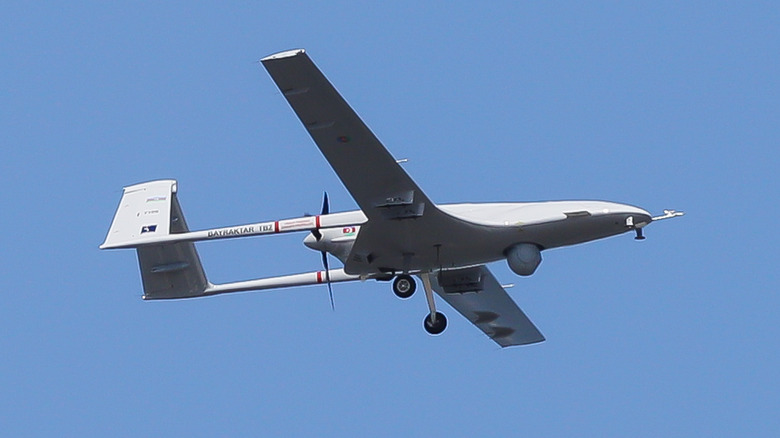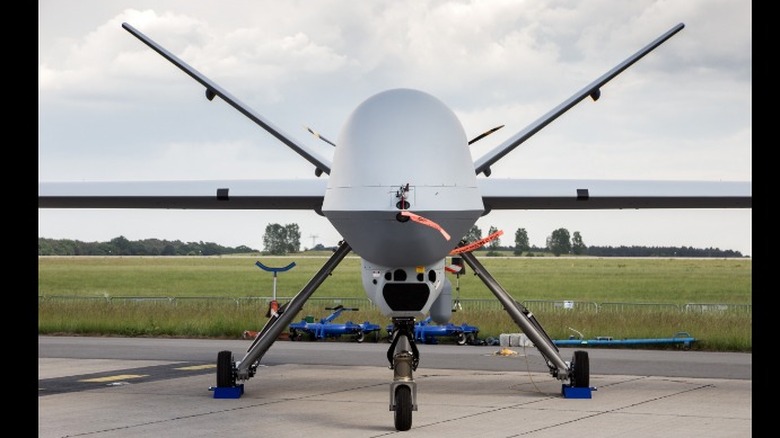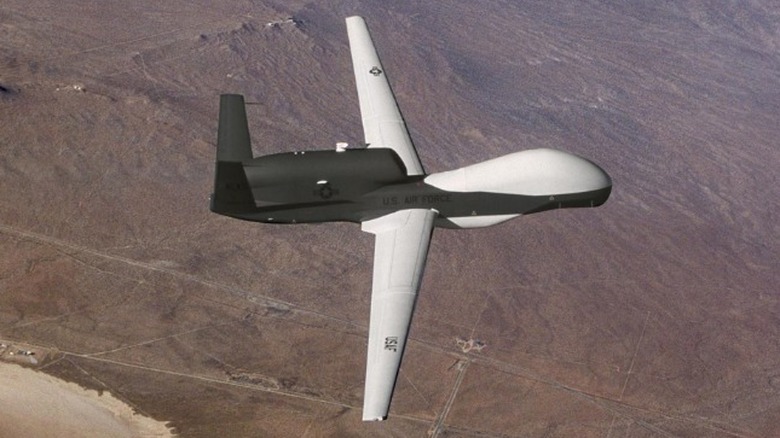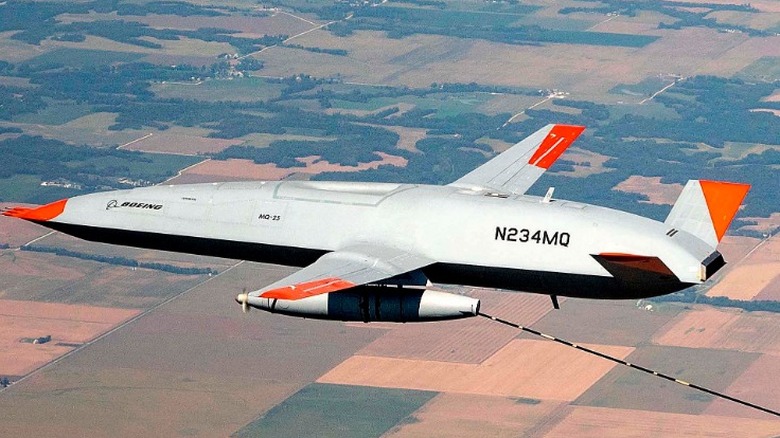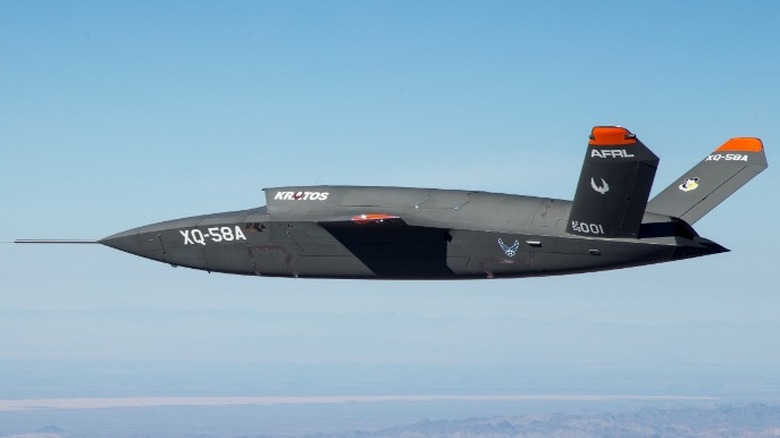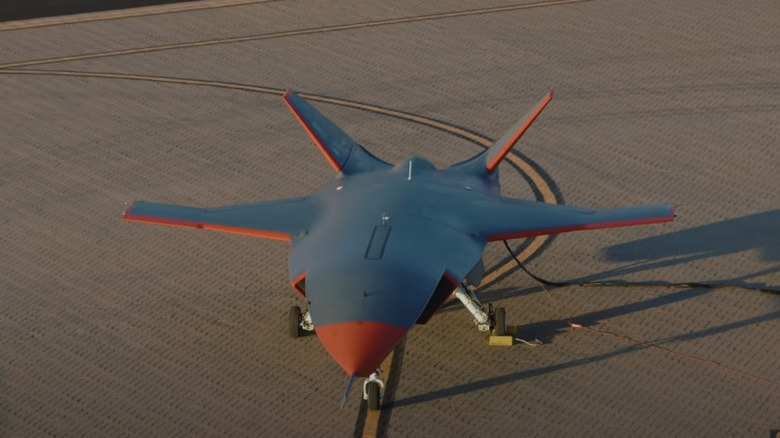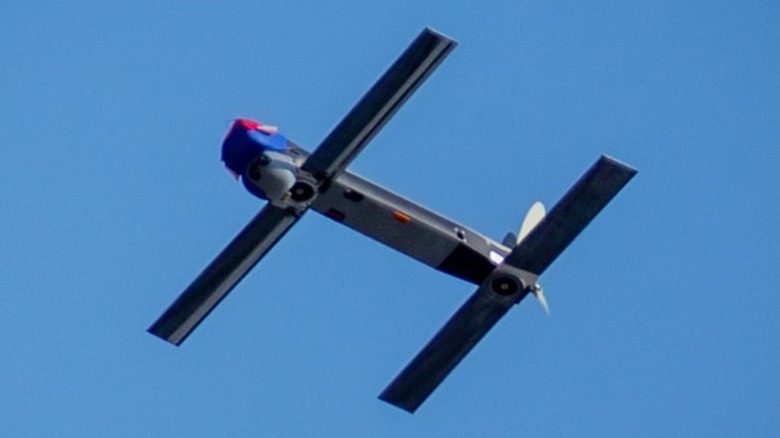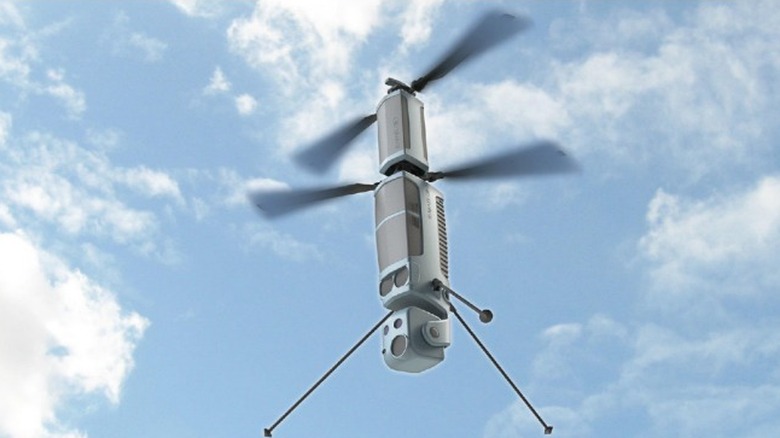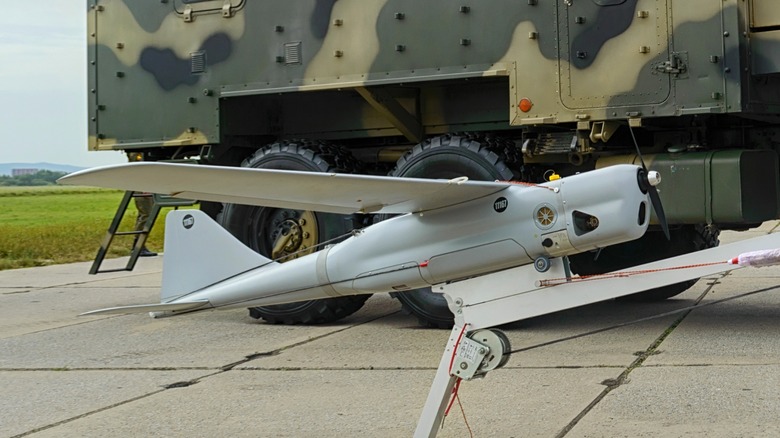10 Terrifying War Drones That Give Us Chills
Modern warfare and national defense make for big business the world over. Countless dollars, pounds, rubles, and yuan are spent by nations trying to stay one step ahead of the next. With the largest military budget in the world, the United States is a leader in the development and production of the Unmanned Aerial Vehicle, or UAV, but is fast becoming just one of many nations around the world to build and export the technology.
The American MQ-1 Predator could be considered the first of the modern UAVs. It was capable of long-range flight to perform reconnaissance or strike a target with hellfire missiles. It was used extensively in the conflicts in Iraq and Afghanistan from the early 2000s until it was retired in 2018. Since then, not only has it been replaced with an upgraded model, but dozens more UAVs have entered service and there are dozens more in development. The UAV has completely changed how military operations are executed (via the BBC), giving commanders precise information about troop movements and changing battlefield conditions at a moment's notice.
Newer UAVs will continue to push the boundaries of what is capable and electronic warfare capabilities will make these vehicles more terrifying than ever. Pitting formidable forces with sophisticated high-tech equipment against each other can cause devastating results for civilians caught in the crossfire. Hopefully, you will never have to face any of these terrifying war machines — but here are ten that give us chills.
Predator C Avenger - United States
The newest successor to the original Predator deployed by US forces, the Predator C Avenger, builds on what made the original so effective and adds more capabilities and sophistication. The Avenger is built to fulfill multiple duties and is equipped with cameras and electronic surveillance as well as armaments. Propelled by a Pratt and Whitney turbofan engine, it can cruise at 50,000 feet at speeds of 400 knots (via General Atomics).
The abilities of the Avenger allow forces to conduct sensitive operations in areas where traditional aircraft would have little cover to safely execute missions. According to Global Security, Avenger drones were used in successful missions to eliminate Al Qaeda's number two in command, Abu Khayr Al Masri, in 2017. It is suggested that these are the kind of missions that might have previously used aircraft such as the F-117 Nighthawk but are successfully completed using lighter, more efficient, and cheaper UAVs without threat to U.S. personnel. The Avenger is somewhat of a workhorse in the U.S. military and many are deployed in hotspots throughout the world, ostensibly to keep Americans back home safe from distant threats.
Bayraktar TB2 - Türkiye
The Baykar company of Türkiye has emerged as a leading international UAV and drone technology supplier. Its popular export UAV is the Bayraktar TB2, which offers an impressive amount of equipment in a relatively small and lightweight package. Furthermore, being developed in a nation as a member of NATO, it adheres to at least some of the NATO operational specifications, a selling point to many of the 30 member states of the alliance (via Baykar Tech). The TB2 is instantly recognizable by its inverted V-tail and has gained notoriety due to its use by the Ukrainian Armed Forces during the Russo-Ukrainian conflict of 2022.
The biggest advantage of the TB2 for a country like Ukraine is the cost. At $10 million for the vehicle and control unit, it comes at a fraction of the cost of American equivalents. They are powered by a 105-horsepower Rotax engine, a notoriously reliable powerplant, and have an operational duration of 27 hours, per Military Today. Furthermore, Forbes notes that the TB2 has provided the Ukrainians a much-needed edge to repel the Russians, whose supplies dwarf those of the Ukrainians, and that the TB2 has managed to eliminate dozens of pieces of Russian equipment while only losing eight of their fleet of thirty. It is probably safe to assume that Russian soldiers should be wary of Bayraktars for the foreseeable future.
Reaper - United States
As a second iteration of the original Predator drone, the MQ-9 Reaper is one of the longest-serving UAVs in the American military. The Reaper also built upon its predecessor, going beyond surveillance capabilities to first strike target elimination. Talking about its purpose within the Air Force, Gen. T. Michael Moseley said," We've moved from using UAVs primarily in intelligence, surveillance and reconnaissance roles before Operation Iraqi Freedom, to a true hunter-killer role with the Reaper" (via U.S. Air Force). It features a 900 horsepower turboprop engine that dwarfs the original Predator's 119 horsepower and can cruise faster and higher, as well as carry 500-pound bombs and Hellfire missiles.
Despite its long service, the Reaper continues to be an integral part of the armed forces. However, in its continuing mission, its technology is currently being updated to address new threats. SlashGear reported in 2021 that preparedness for the Reaper UAVs had shifted away from counter-terrorism missions to readiness against "near-peer" threats. The USAF sees an evolving geopolitical landscape and is constantly preparing for possible threats on the horizon, even when no specific evidence shows an imminent threat. Whether the threat comes from an insurgent terrorist group or a rogue state, the Reaper presents formidable opposition in the skilled hands of the U.S. military.
Global Hawk - United States
The Northrop Grumman RQ-4 Global Hawk is the biggest and most impressive UAV in the American fleet. It is powered by an Allison/Rolls Royce turbofan engine and boasts a wingspan of 130 feet, per Veteran Life. It is a reconnaissance vehicle and can stay aloft at 60,000 feet for up to 32 hours. It carries an array of advanced communications and detection equipment to provide pinpoint accuracy for advanced strike forces waiting for intelligence worldwide.
Gathering such advanced information does not come cheap. The Global Hawk comes at a cost of $99 million, but that price can go up to $130 million with additional sensors and other equipment for specific capabilities. It is also one of the longest-serving UAVs in the American military with its first deployments happening as early as 2001 before it had completed its prototype phase and is regularly used in NATO missions abroad. The war in Afghanistan rushed its final development and sped up the timeline to be put into operation. It is especially formidable to anyone trying to hide from the US military as it can see with utmost detail just about anywhere in the world, day or night.
Stingray - United States
Some UAVs become a menace to the enemy just by what it can see or do, but by how it can help others with their mission. The MQ-25 Stingray is a perfect example of a support craft that extends the missions of manned aircraft during deployment. The U.S. Navy says the MQ-25 is the world's first carrier-based unmanned aerial refueling aircraft. The first successful refueling occurred in June 2021. It incorporates surveillance and reconnaissance technology and refueling capabilities to support aircraft deployed from Navy vessels. It is currently undergoing testing and shall be operational for use by the Navy soon.
The F-35 Joint Strike Fighter is the most advanced warplane produced to date and currently leads the American military's fleets along with our NATO partners and other aligned nations. It is a multi-role aircraft but it has fierce competition from the Russian Su-57. 19fortyfive lays out the competitive capabilities of the two planes and one specification shows a stark difference. The American fighter jet has a range of 1,379 miles while the Russian can traverse 3,107. This means the F-35 must stay closer to home to ensure safe returns. Still, with the added range from in-flight refueling, the range can be significantly extended for the F-35 and other aircraft, ensuring air superiority in a hypothetical matchup against the Su fighter. It is hoped that having the capability alone is enough to ever see an actual matchup in the air.
Valkyrie - United States
In a combat zone, the sight of American warplanes should be enough to cause significant alarm for a possible foe as they are among the best equipped in the world. This could be stepped up exponentially if each of those same fighter jets arrived accompanied by a couple of autonomous drones alongside them. The XQ-58A Valkyrie is in development as part of an autonomous drone program to develop unmanned "wingmen" that can fly using AI based on inputs from the pilots of the manned aircraft, per Defense News. This could expand the firepower and amount of available armaments to the point of total devastation for opposing forces.
For soldiers on the battlefield, the arrival of a couple of F-35 fighters both flanked by a couple of drones would be an ominous sight. If and when this technology gets into operation, it will step up the military capabilities to the next level. Its first successful test flight was in March 2019. To dispel rumors that these are just experimental, only to be in use in some far-off future, The War Zone reports that the first one used for testing is going to the USAF museum, and that it was built with near full capabilities that go well beyond being just a proof of concept demonstration. Future enemies of the US should take notice.
Ghost Bat - Australia
Boeing has an Australian division and part of its function is to develop aircraft for the Royal Air Force. While their military may not be as large and well-funded as the US, it is a high-tech and well-equipped fighting force. The first aircraft to be completely produced by Australians in a half-century is shaping up to be similar to the Valkyrie UAV, a semi-autonomous aircraft that uses AI for flight control, according to New Atlas. The project had been known as Loyal Wingman but is now referred to by its official moniker, MQ-28A Ghost Bat. Giving it an official designation represents another step toward completion and deployment of the project, and naming it after a species native to Australia helps denote it as an Aussie original.
The project is a joint effort between the Royal Air Force and Boeing's Australian division. With the heavy involvement of an American company and the historical sharing of intelligence and hardware means that the Ghost Bat will be adopted elsewhere, with the USAF Secretary recently giving the program praise and signaling continued investment in autonomous AI technology. Given Australia's significant geographic isolation, the Ghost Bat may be most menacing to rogue wallabies, but should the RAAF join its defense partners in combat, this will be a fearsome component of their fleet.
AeroVironment Switchblade - United States
The Switchblade falls into a bit of a different category of UAV as it isn't meant to return home once launched. This is a relatively new and terrifyingly effective class of unmanned vehicles called a loitering munition. The manufacturer calls it a loitering missile and claims it to be ideal for use against targets that are beyond visual range. They are launched from lightweight, portable tubes that can be carried in a backpack and deployed in minutes. Once launched, the user has the ability to control the vehicle for up to ten minutes, using a tablet-style controller with visuals from a camera mounted to the drone. The Switchblade can detonate its payload on impact or be used for reconnaissance and turned back if a mission is aborted.
The Switchblade was among the first weapons sent to Ukraine to aid in its defense against invading Russian forces, according to Bloomberg. They initially received the Switchblade 300, which has a ten-minute loitering time with a range of up to six miles. Plans laid out in May 2022 call for sending Switchblade 600s, which has a loitering time of 40 minutes, a 24-mile range, and can deliver enough explosives to pierce the armor of a tank. Their small size, pinpoint precision aim, and ability to change trajectory after launch makes them a formidable weapon. With a cost, according to Engineerine, of up to $10,000 for the larger variant, the Switchblade is also a highly cost-effective weapon considering it can eliminate vehicles worth millions.
Spike Firefly - Israel
Israel has long been known for having a fierce and capable military, having driven neighboring invaders from its borders for decades. It is also a loyal partner to the U.S. military. The Uzi submachine gun is one of the most widely known of any of its homegrown defense products.
Israel-based Rafael produces a range of defense weapons and intelligence gathering systems and it produces the Firefly loitering munition. Unlike the Switchblade, which uses fixed wings for flight, the Firefly relies on a counter-rotating rotor setup similar to a helicopter or consumer-grade drone. According to Army Technology, a full system consists of three loitering munitions as well as the control unit. The full package weighs just over 30 pounds with each munition being less than seven. It is also controlled by a tablet and can remain aloft for either 15 or 30 minutes depending on if it is equipped with one or two batteries. The rotors allow it to hover in place and it is said to remain stable in wind speeds up to 30 mph.
Being able to hover and move discreetly, transmitting video and other data back to the operator makes it ideal for use in close quarters. Israel is a rather small country with experience in urban warfare, likely a large reason for its development.
Orlan-10 - Russia
Throughout the cold war, the Soviet Union presented the West with a formidable foe, purported to have one of the most expansive and heavily armed militaries in the world (via History). Since the fall of communism, much has been said of the buildup of the modern Russian military and its aggressive modernization and mobilization efforts.
Drones are playing an outsized role in combat during Russia's current invasion of Ukraine, and Russia's most used drone appears to be the Orlan-10. According to Global Security, Special Technology Center produces the Orlan in 11 different variants with the primary purpose being reconnaissance. However, Forbes reports that drones recently captured by the Ukrainian military are shown to be carrying common consumer electronics components such as Canon digital cameras held in place with velcro straps and a fuel tank lid from a common soda bottle.
The Russian Orlan drone is not a menacing war drone in the sophisticated way others on this list are. Another captured Orlan shows a ramshackle mix of components made from many Western countries despite the oppressive sanctions in place (via The Defense Post). What makes Orlan give us chills is that its operators are using it to target civilians and civilian infrastructure. They are helping to rain terror from the skies down on innocent Ukrainian lives and it is heartbreaking, proving drones don't have to be sophisticated to be terrifying.
